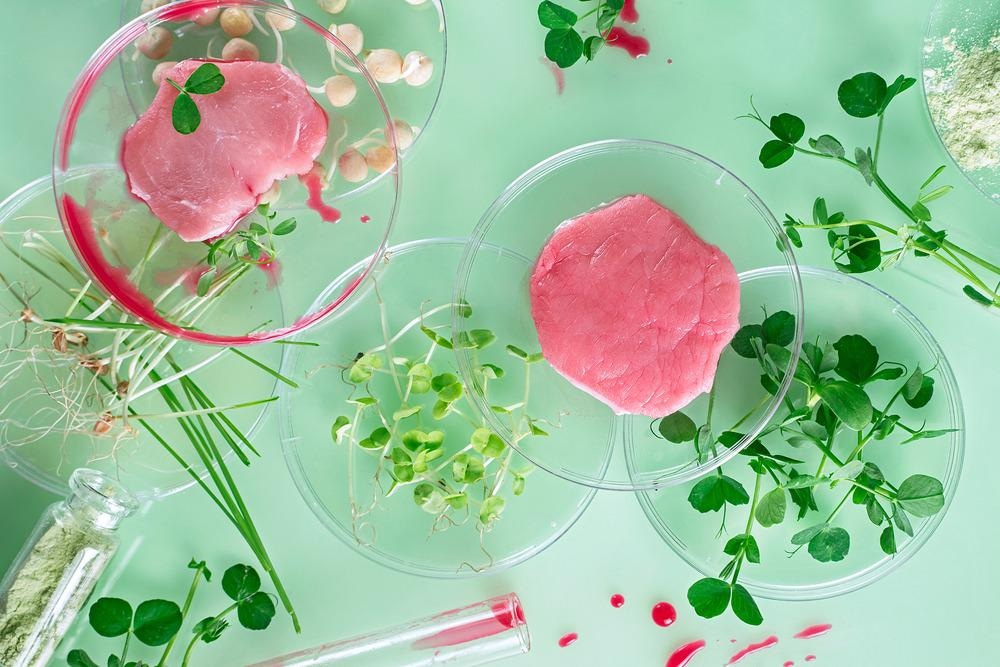 By Surbhi JainReviewed by Susha Cheriyedath, M.Sc.Apr 29 2022
By Surbhi JainReviewed by Susha Cheriyedath, M.Sc.Apr 29 2022In an article recently published in the journal Biomaterials, researchers discussed the development of 3D porous scaffolds made of wheat glutenin for use in cultured meat.

Study: 3D porous scaffolds from wheat glutenin for cultured meat applications. Image Credit: DyrElena/Shutterstock.com
Background
The demand for alternative proteins to address livestock-related environmental degradation, rising meat consumption, human nutrition, food safety, animal welfare concerns, and other considerations has prompted the development of cultured meat. Large-scale production is one of the major obstacles to the commercialization of cultured meat. Scaffold biomaterials act as supporting networks that enable cell attachment and oxygen and nutrition transfer into thick tissues. Alternative crosslinkers are required for the synthesis of scaffolds for cultured meat.
Proteins are frequently selected as scaffold biomaterials for medical purposes because of their natural involvement in human cells. Although extracellular proteins (ECM) aid cell proliferation and adhesion, they should be avoided in the production of cultured meat scaffolds because they are either animal-based or require currently expensive recombinant production, which is incompatible with cultured meat's low-cost and animal-free requirements.
About the Study
In this study, the authors used wheat glutenin to create 3D porous scaffolds for cultured meat applications. For the manufacture of porous glutenin sponges and fibrous aligned scaffolds, a physical cross-linking approach based on water annealing was developed.
The researchers investigated the use of glutenin as a scaffold material derived from wheat gluten for cultured meat. A new approach was tested for making scaffolds out of glutenin that could sustain mammalian cell growth. C2C12 mouse skeletal myoblasts and primary isolated bovine satellite cells (BSCs) were used in the experiments. 3D porous sponges and aligned fibrous scaffolds were produced and described, and muscle cell proliferation and differentiation on the materials were investigated.
The team determined the use of glutenin scaffolds in C2C12 mice skeletal myoblasts and BSCs to proliferate and differentiate without the need for particular cell adhesion proteins or other coatings. The usage of hazardous cross-linkers and animal-derived extracellular matrix (ECM) coatings was avoided in the low-cost and food-safe production process.
Observations
In comparison to the 5% glutenin scaffolds, the 2.5% glutenin scaffolds with BSCs had a less compact structure. The 2.5% glutenin scaffold had more aligned fibrous structures, while the 5% glutenin scaffold had more aligned sheet structures. C2C12 differentiation was encouraged by glutenin sponges with concentrations of 2%, 3%, 4%, and 5% glutenin. In comparison to the 2%, 3%, and 4% glutenin scaffolds, the 5% glutenin scaffold produced shorter myotubes. The fusion and maturity index revealed no significant differences between the 2%, 3%, and 4% sponges, while the 5% glutenin scaffold had a significantly lower fusion and maturation index.
Glutenin sponges with concentrations of 3%, 4%, and 5% all showed an increase in metabolic activity after 14 days. In comparison to the 3% and 4% glutenin sponges, the 5% glutenin sponge had decreased metabolic activity. The water-holding capability of glutenin sponges revealed that the 2% glutenin sponges absorbed the least amount of water. Glutenin sponges with concentrations of 3%, 4%, and 5% demonstrated similar water absorption: roughly 1,500% of their initial weight. At 1-5% strain, the compressive modulus of 5%, 4%, 3%, and 2% glutenin sponges was 1.9, 1.8, 0.7, and 0.5 kPa, respectively, whereas Young's compressive modulus of bovine muscle was 1.2 to 1.8 kPa.
Despite the fact that no cross-linking chemical reagents were used in the manufacturing process and no ECM proteins or other coatings were used, the muscle cells present on the glutenin scaffolds showed good proliferation and differentiation. The results revealed that after the water annealing, the secondary structure of glutenin had decreased random coil content and enhanced β431 sheet and α-helix development, which implied intramolecular hydrogen bonding.
Conclusions
In conclusion, this study elucidated that glutenin is a potential candidate for cultured meat production demands as it is a cheap and abundant supply of raw protein material. It was shown that muscle cells proliferate on, attach to, and differentiate on glutenin scaffolds, which indicated that this abundant protein supply could be a promising choice for future cell-cultured meat requirements. Steam sterilization, which worked as a water annealing process, generated hydrogen bonding between macromolecules, and encouraged crystallization to stabilize 3D structures, was a critical step to producing growth media-stable glutenin scaffolds.
The authors emphasized that the development of appropriate scaffolds is a critical necessity for cultured meat production. They also believe that the proposed methods will encourage the use of low-cost, plentiful plant-based materials as scaffolding materials in cellular agriculture applications.
More from AZoM: What Multi-Analytical Techniques are Used to Assess Paintings?
Disclaimer: The views expressed here are those of the author expressed in their private capacity and do not necessarily represent the views of AZoM.com Limited T/A AZoNetwork the owner and operator of this website. This disclaimer forms part of the Terms and conditions of use of this website.
Source:
Xiang, N., Yuen, J. S. K. Jr., Stout, A. J., et al. 3D porous scaffolds from wheat glutenin for cultured meat applications. Biomaterials 121543 (2022). https://www.sciencedirect.com/science/article/abs/pii/S0142961222001831